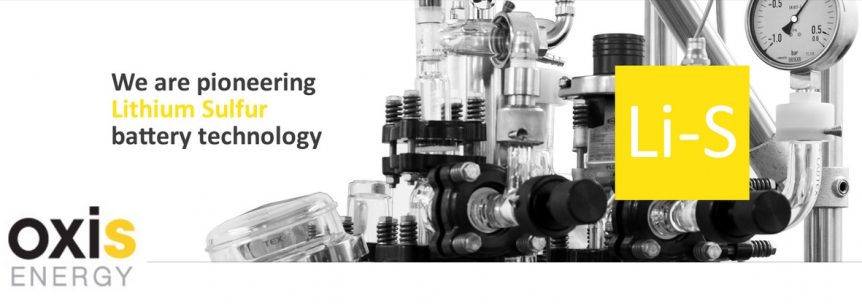That near-mythical 10X (of current lithium cells’ energy density) battery hangs out there on the distant horizon, promising automobiles that can exceed 1,000 miles range, or light aircraft that can carry four at Cessna-like distances. Right now, we have two-place trainers good for an hour’s laps around the circuit, and the hope for improvements soon. OXIS Energy, a UK-based company, has achieved 425 Watt-hours per kilogram at the cell level, and looks to go higher in the near future. Lithium-Sulfur – A Worthy Alternative? Promoters of lithium-sulfur batteries suggest their products have several desirable characteristics and performance boosts that may transcend the limits of lithium-ion cells. Sion Power, for instance, claims availability of their Licerion battery with an even better 500 Watt-hours per kilogram and 1,000 Watt-hours per liter. On the same track, OXIS Energy has announced they have a demonstrated 425 Wh/kg cell, expected to rise to 450 Wh/kg by the end of the year and to 500 by …
Safe Rechargeable Solid State Batteries
If the man responsible for co-invention of the lithium-ion battery says he has found ways to make it better while eliminating its less desirable characteristics – we will listen. 94-year-old John Goodenough, professor in the Cockrell School of Engineering at The University of Texas at Austin, says as much. He and researchers including Maria Helena Braga, claim to have created “A low-cost all-solid-state battery that is noncombustible and has a long cycle life (battery life) with a high volumetric energy density and fast rates of charge and discharge.” Their findings can be found in the journal, Energy & Environmental Science. Non-combustibility is a big sales point for those worried about having their vape pipe vaporize their underwear, or having a flight-diverting event on their jetliner. Long cycle life will appeal to people seeing the odometer on their EV turn over in the left-most column. High volumetric energy density will lighten up the car (or airplane) and make it perform better. …
Solid State Electrolyte – a Safer, More Powerful Alternative
Making batteries smaller, lighter, and more powerful is an ongoing trend, supposedly climbing at eight percent per year in terms of energy density (energy stored per unit of weight). Even this blog is guilty of sometimes unrequited enthusiasm for some new developments that appear to be an “answer” for aircraft use. Getting a battery that double or quintuples energy density would be ideal for aircraft, but seems to be a labor worthy of Sisyphus (you could look it up). As constantly noted here, batteries have three major components, the anode, or negative electrode; the cathode, or positive electrode; and the electrolyte, usually a liquid that allows the flow of ions between electrodes. That electrolyte is subject to overheating and on rare occasions, bursting into flames. That has led researchers at MIT, Samsung, and in California and Maryland to develop a solid-state electrolyte that might overcome the safety issue while providing more energy storage in a given space. Yan Wang, an …
BASF NiMH Battery Rebirth?
BASF, according to Wikipedia, “is the largest chemical producer in the world and is headquartered in Ludwigshafen, Germany. BASF originally stood for Badische Anilin- und Soda-Fabrik (English: Baden Aniline and Soda Factory). Today, the four letters are a registered trademark….” With ongoing research into increasing energy storage capabilities of nickel metal hydride (NIMH) batteries to rival or exceed that of lithium batteries, BASF could make breakthroughs in building a safer, lower-cost battery. Using an Advanced Research Project Agency – Energy (ARPA-E) award of $3.8 million, the company is working on a project titled, “High Performance NiMH Alloy for Next-Generation Batteries.” Funding applies through February of next year. ARPA-E’s project description lists some of the anticipated benefits of “these new battery chemistries,” including better energy density allowing up to three times the driving range of current products, prevention of overheating, and immunity to catastrophic failure. The improved NIMH batteries could be “incorporated into the structure of a vehicle to improve strength in some cases. Much of this can be accomplished at a 30% lower …
Dr. Cui’s Pomegranate-inspired Battery Bears Fruit
Dr. Yi Cui seems to get inspiration from food. A few years ago, his research team came up with a “yolk-shell structure” that helped contain the high amount of lithium that silicon anodes were able to absorb. That battery design promised much, and an embellishment of that design seems to hold even greater promise. His newest effort, working at Stanford University with the Department of Energy’s SLAC National Accelerator Laboratory, features an electrode “designed like a pomegranate – with silicon nanoparticles clustered like seed in a tough carbon rind.” This approach, according to its inventors, overcomes several remaining obstacles to the use of silicon in a new generation of lithium-ion batteries. Yi said the battery’s efficiency and longevity are promising. “Experiments showed our pomegranate-inspired anode operates at 97 percent capacity even after 1,000 cycles of charging and discharging, which puts it well within the desired range for commercial operation.” Cui’s team has been working on preventing anode breakup for the …


